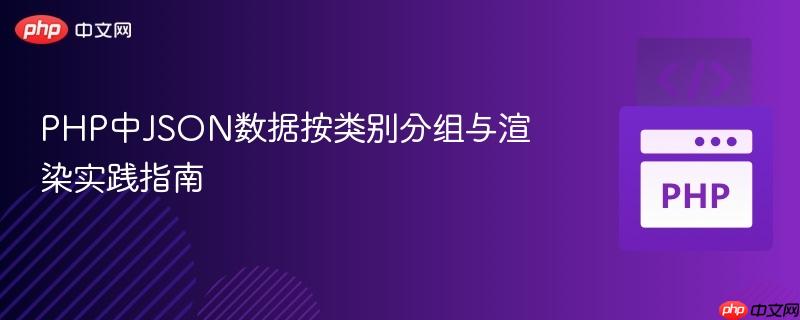
在web开发中,处理json(javascript object notation)数据是一项常见任务。php提供了强大的内置函数来解析和操作json。本教程将指导您如何将一个包含多条记录的json数组,按照其中一个字段(例如“category”)进行分组,并最终以结构化的html形式展示出来。
1. JSON数据准备与解码
首先,我们需要一个JSON字符串作为示例数据。这个JSON字符串包含了一个文章列表,每篇文章都有“article”(链接)、“category”(类别)和“title”(标题)字段。
json_decode($json, true)是关键一步,它将JSON字符串转换为PHP的关联数组,方便我们通过键名访问数据。
2. 数据按类别分组
为了按类别显示数据,我们需要对解码后的 $values 数组进行预处理,将其重新组织成一个以类别名为键,值为该类别下所有文章数组的新数组。
[ // ["article" => "...", "category" => "Cat2", "title" => "..."], // ["article" => "...", "category" => "Cat2", "title" => "..."] // ], // "Cat1" => [ // ["article" => "...", "category" => "Cat1", "title" => "..."], // ["article" => "...", "category" => "Cat1", "title" => "..."], // ["article" => "...", "category" => "Cat1", "title" => "..."] // ] // ] ?>
这个 foreach 循环遍历原始文章列表,根据每篇文章的 category 字段,动态地构建了一个新的 $res 数组。array_key_exists() 确保每个类别只初始化一次。
立即学习“PHP免费学习笔记(深入)”;
3. 渲染分组后的数据到HTML
数据分组完成后,我们就可以遍历 $res 数组,并将其渲染到HTML页面上。这里使用嵌套的 foreach 循环:外层循环遍历类别,内层循环遍历每个类别下的文章。
文章分类展示
$entry_list): // $category 是类别名, $entry_list 是该类别下的文章数组
?>
关键修正点: 在原始问题中,内层循环错误地使用了 = $entry['title']; ?>。由于内层循环的变量是 $article,它代表了当前遍历到的单篇文章,因此正确的访问方式应该是 $article['article'] 和 $article['title']。上述代码已进行了修正。
4. 完整代码示例
将上述所有部分整合,形成一个完整的PHP脚本:
文章分类展示
$entry_list): ?>
5. 注意事项与最佳实践
- 错误处理: 在实际应用中,json_decode() 可能会因为无效的JSON字符串而返回 null。务必使用 json_last_error() 和 json_last_error_msg() 进行错误检查。
- 安全: 在将任何用户提供或外部数据输出到HTML时,始终使用 htmlspecialchars() 函数来转义特殊字符,以防止跨站脚本攻击(XSS)。本教程中的示例已包含此项。
- 可读性: 对于更复杂的视图逻辑,可以考虑使用PHP的模板引擎(如Twig、Blade等),它们能更好地分离业务逻辑和视图呈现。
- 数据结构理解: 深入理解您正在处理的JSON数据结构是编写正确解析和渲染逻辑的基础。
- 性能: 对于非常大的JSON数据集,考虑分批处理或优化数据结构以提高性能。
总结
通过本教程,您应该已经掌握了在PHP中解析JSON数据、根据特定键对数据进行分组,并将分组后的数据渲染到HTML页面的基本方法。理解 json_decode() 的用法、数组操作技巧以及循环遍历时的变量作用域是成功实现此类功能的关键。同时,遵循错误处理和安全实践将有助于构建健壮和可靠的Web应用程序。































